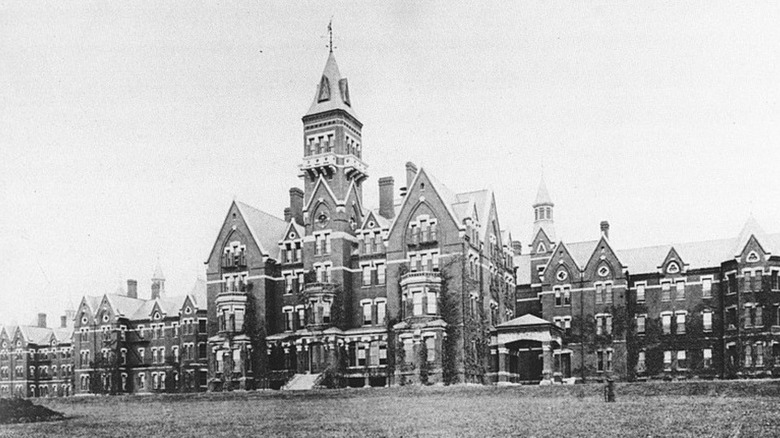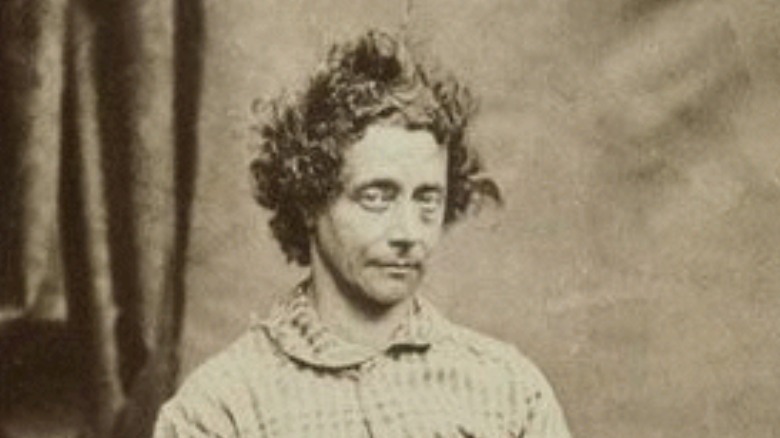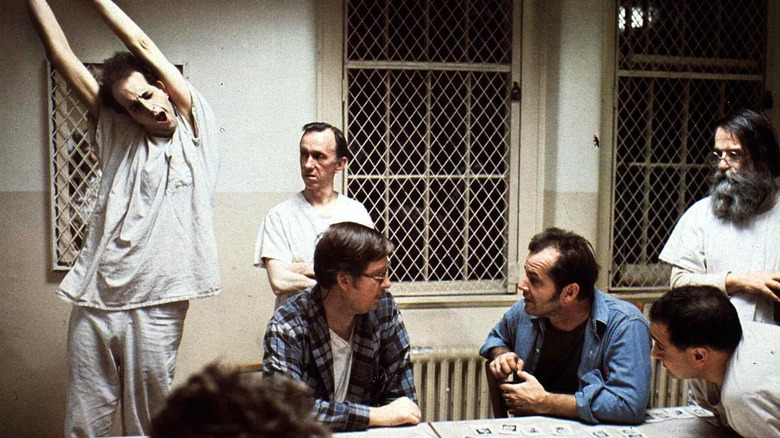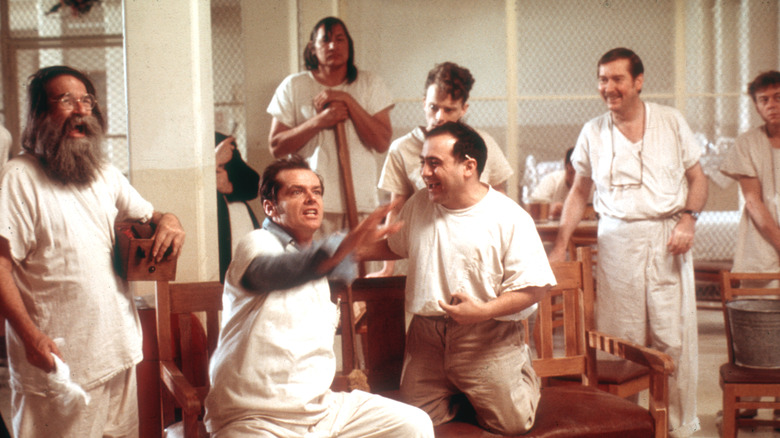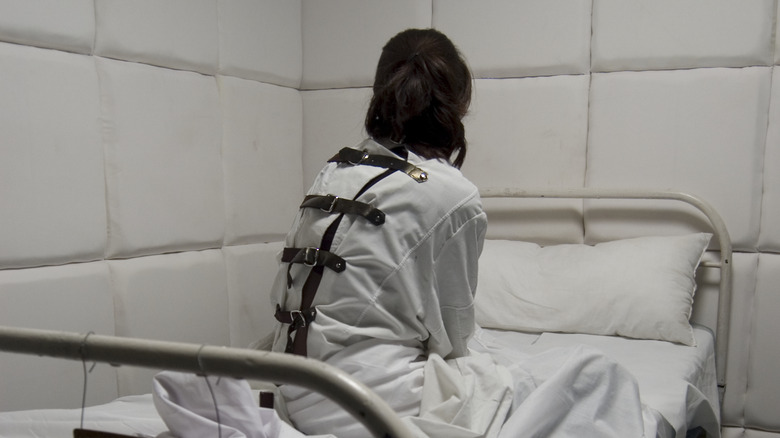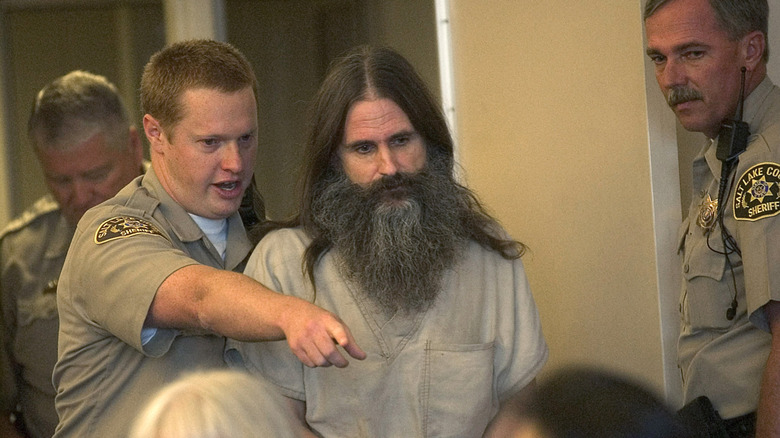What Life Inside A Maximum-Security Psychiatric Hospital Is Like
There are two ways to get into a maximum-security psychiatric hospital. The first is to work there. The second is to commit a violent crime for which it is determined — or is in the process of being determined — to have been caused by serious mental illness. Those accused of crimes, whose sanity is in question by the courts, are held at maximum-security psychiatric wards to see if they are competent to stand trial, as are those found guilty of crimes by reason of insanity. In both cases, the amount of time patients (they're not called inmates there) will spend in the facilities is indefinite.
According to what author and college professor Mikita Brottman told A&E, after running a book club at Maryland's state-run Clifton T. Perkins Hospital Center and writing a book on one of its patients who killed his parents, patients stay until they are deemed better or able to be back in society. That could mean a year or the rest of their lives. Brottman said that no outside agencies monitor the patients' progress or the time they spend in the hospitals.
Patients have more freedoms than inmates
Life in a maximum security psychiatric hospital is not the same as in prison, according to ABC 13, who went inside the only such facility in Texas. Jeff Bearden, director of the hospital's Forensic Psychiatric Program, told ABC13, "Once they're admitted, the handcuffs and shackles come off and they become patients of the public mental health system."
That means they are treated differently than prison inmates. In a way, they have more freedoms, including the fact that in most facilities, women and men are in the same buildings, according to what Brottman told A&E. She said patients can wear regular clothes and are not identified by numbers, as they are in the prison system. Because they are patients, they are given regular medications and therapy or treatment from doctors. Friends and family can visit and hugs are allowed. However, they are watched by guards and the buildings are surrounded by fencing.
According to Brottman, some patients would rather be prison or jail, because "They're treated with more dignity."
She elaborated that as a patient in a maximum security psychiatric hospital, everything you do is viewed as "a symptom instead of a rational choice that anyone might make. In prison, you can stay in your room, you can choose not to go to meals, you can choose not to go out into the yard, and it's not jotted down in your file as a symptom of an illness — it's just a choice."
Mundane days punctuated by violence
According to Pew's Stateline, reporting in 2018, roughly 14% of all state and federal inmates have a serious mental illness, as do 26% of jailed inmates, but in many cases, the resources to treat them aren't there. For the criminally insane who end up in a psychiatric prison, the days are filled with the mundane and punctuated by violence.
They are made to rise early for breakfast. They are only allowed to eat with spoons. There is a lot of waiting and standing around. People play cards and watch TV, and can sometimes go outside for recreation. Some are given jobs. There can be classes offered by volunteers, like Brottman's book club, or yoga, or even debate club. As Brottman told A&E, "Basically, it's pretty monotonous and there's a lot of downtime with nothing in particular to do."
But there is also violence, as one might expect from those whose mental illness often manifests in brutal acts. Dr. Stephen Seager of Napa State Psychiatric Hospital wrote the 2014 book "Behind the Gates of Gomorrah: A Year With the Criminally Insane." He told The Daily Beast he wrote the book without the blessing of his workplace because "We're getting the s*** kicked out of us and no one cares. Not just the staff, the patients. And they can't leave at the end of the day — they have to live there. If this stops one of them from getting beaten, it was all worth it."
'You have to laugh or you'll go insane'
The problem, Seager said, is that there is nothing "secure" about a maximum security psychiatric hospital — at least, not for the people inside. He told The Daily Beast that he toned down the violence he relates in his book.
"It's worse than I made it out in the book," he said. "I have half of my nurses out on disability at any one time. Almost all of the doctors have been assaulted at one time or another, usually when you have your guard down."
Some patients do get better, said Seager, but the violence inside the facilities makes it harder for those who are improving because it "really sets them back." The violence is generally perpetuated by 15-20% of the patients 90% of the time, he told The Daily Beast. He thinks if they could get those patients separated, it would likely help the others improve, but the people who end up in his hospital are those who are the most dangerous to society.
Seager described the patients in maximum security psychiatric hospitals as "the school shooters, the James Holmeses, and Jeffrey Dahmers of the world," but also told The Daily Beast, "I've really gotten to be friends with a lot of these people. All of my friends at work are murderers or rapists," he joked. "You have to laugh or you'll go insane."
'Treacherous warehouses'
There are no easy answers in dealing with the criminally insane. The people inside have committed the very worst crimes against humanity and have to be taken out of society to protect others. Yet it's costly to house and treat them. For employees of maximum security psychiatric hospitals, their safety is at risk every time they go to work.
A Pulitzer Prize-winning, five-part investigative piece done by the Tampa Bay Times in conjunction with the Sarasota Herald-Tribune in 2016 called "Insane. Invisible. In Danger" highlighted the way Florida's budget cuts and neglect have led turned psychiatric facilities for the criminally insane "into treacherous warehouses where violent patients roam the halls with no supervision and workers are left on their own to oversee dozens of people. Now, no one is safe inside."
The series told story after story of a staff ill-prepared to deal with the violence inside, which has sometimes led to the death of patients. In the third segment of the series, the Times/Herald-Tribune describes the staff as "overworked ... some inept, others poorly trained, all of them underpaid and operating under pressure to keep costs down — often leave patients to fend for themselves."
In the second segment, the investigation highlights how, under Florida law, state officials are not mandated to release information on how patients die as long as the overseeing agency, The Department of Children and Families, deems the death was not the fault of the staff, leaving families in the dark.
'There are lots of grey areas'
For all of the shortcomings and struggles of such a difficult situation for all involved, the goal is to make the criminally insane functional and mentally healthy, including getting patients well enough to stand trial. ABC 13's reporting on North Texas State Hospital says that the patients who have court dates pending are trained in courtroom etiquette, the roles of courtroom personnel, and even training in basic job skills.
But as the Times/Herald-Tribune reported, oftentimes that's like putting a band-aid on a severed toe, because for some, they may get temporarily better long enough to go to court, but they are not really better and end up in a cycle of arrests, short-term psychiatric treatment, a slap on the wrist from the courts for whatever minor crime they committed, and back again.
The problems are vast and people are complicated. As Brottman told A&E, in her experience there are people in forensic psychiatric hospitals who are articulate and intelligent with fears and needs like everyone else, adding, "It's just too easy to see it as evil people doing evil things. There's less of a line between the perpetrator and victims than most people think. Perpetrators can be victims, too. It's much more complicated than it seems and there are lots of grey areas when it comes to crime."
